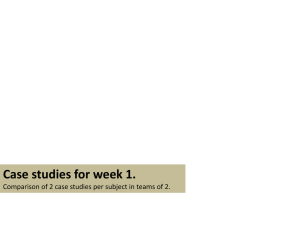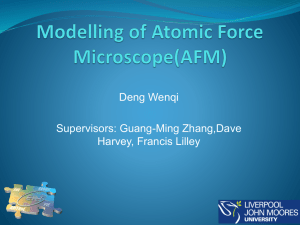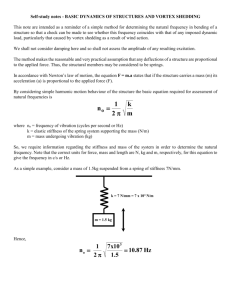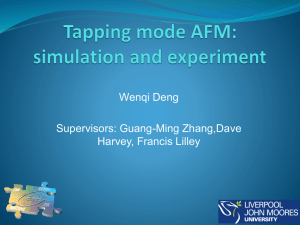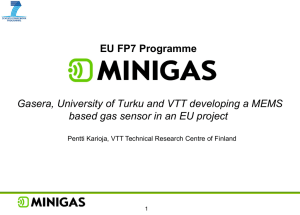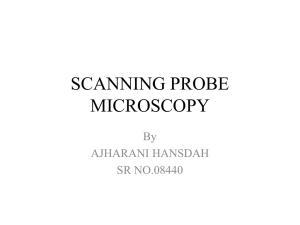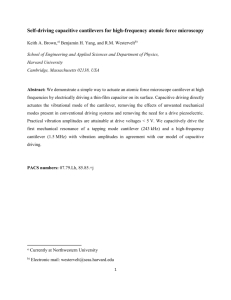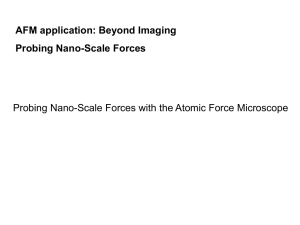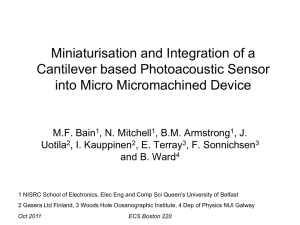Tapping mode atomic force microscopy in liquid with an insulated
advertisement
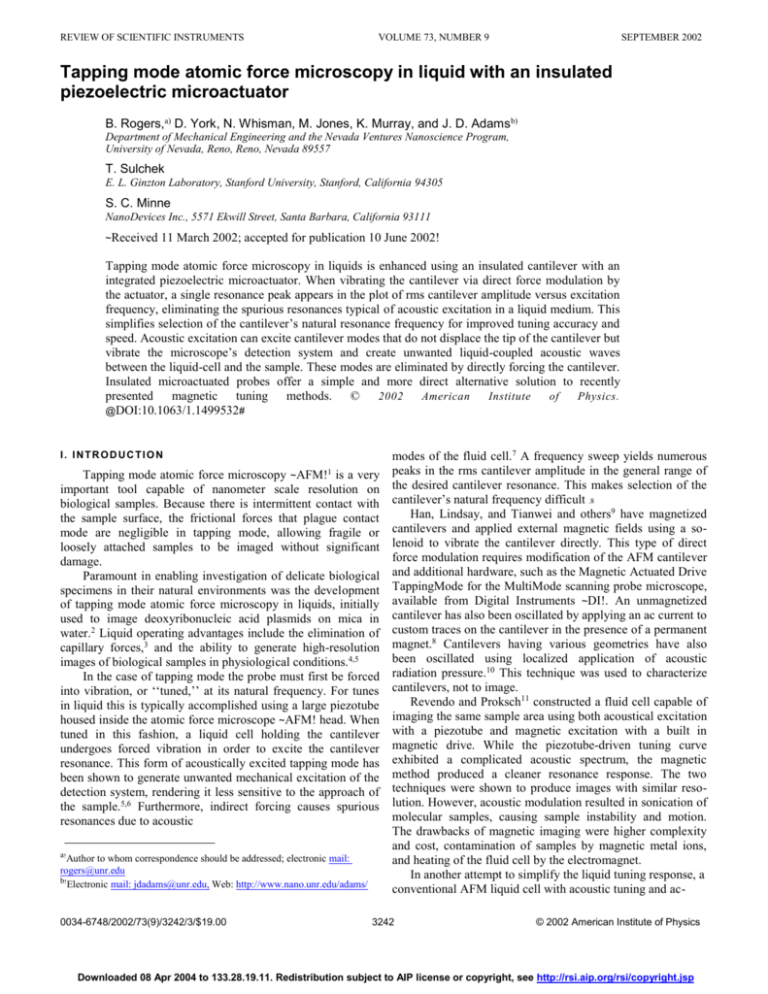
REVIEW OF SCIENTIFIC INSTRUMENTS VOLUME 73, NUMBER 9 SEPTEMBER 2002 Tapping mode atomic force microscopy in liquid with an insulated piezoelectric microactuator B. Rogers,a) D. York, N. Whisman, M. Jones, K. Murray, and J. D. Adamsb) Department of Mechanical Engineering and the Nevada Ventures Nanoscience Program, University of Nevada, Reno, Reno, Nevada 89557 T. Sulchek E. L. Ginzton Laboratory, Stanford University, Stanford, California 94305 S. C. Minne NanoDevices Inc., 5571 Ekwill Street, Santa Barbara, California 93111 ~Received 11 March 2002; accepted for publication 10 June 2002! Tapping mode atomic force microscopy in liquids is enhanced using an insulated cantilever with an integrated piezoelectric microactuator. When vibrating the cantilever via direct force modulation by the actuator, a single resonance peak appears in the plot of rms cantilever amplitude versus excitation frequency, eliminating the spurious resonances typical of acoustic excitation in a liquid medium. This simplifies selection of the cantilever’s natural resonance frequency for improved tuning accuracy and speed. Acoustic excitation can excite cantilever modes that do not displace the tip of the cantilever but vibrate the microscope’s detection system and create unwanted liquid-coupled acoustic waves between the liquid-cell and the sample. These modes are eliminated by directly forcing the cantilever. Insulated microactuated probes offer a simple and more direct alternative solution to recently presented magnetic tuning methods. © 2002 American Institute of Physics. @DOI:10.1063/1.1499532# modes of the fluid cell.7 A frequency sweep yields numerous Tapping mode atomic force microscopy ~AFM!1 is a very peaks in the rms cantilever amplitude in the general range of important tool capable of nanometer scale resolution on the desired cantilever resonance. This makes selection of the biological samples. Because there is intermittent contact with cantilever’s natural frequency difficult .8 9 Han, Lindsay, and Tianwei and others have magnetized the sample surface, the frictional forces that plague contact mode are negligible in tapping mode, allowing fragile or cantilevers and applied external magnetic fields using a soloosely attached samples to be imaged without significant lenoid to vibrate the cantilever directly. This type of direct force modulation requires modification of the AFM cantilever damage. Paramount in enabling investigation of delicate biological and additional hardware, such as the Magnetic Actuated Drive specimens in their natural environments was the development TappingMode for the MultiMode scanning probe microscope, of tapping mode atomic force microscopy in liquids, initially available from Digital Instruments ~DI!. An unmagnetized used to image deoxyribonucleic acid plasmids on mica in cantilever has also been oscillated by applying an ac current to on the cantilever in the presence of a permanent water.2 Liquid operating advantages include the elimination of custom traces 8 capillary forces,3 and the ability to generate high-resolution magnet. Cantilevers having various geometries have also been oscillated using localized application of acoustic images of biological samples in physiological conditions.4,5 10 In the case of tapping mode the probe must first be forced radiation pressure. This technique was used to characterize cantilevers, not to image. into vibration, or ‘‘tuned,’’ at its natural frequency. For tunes Revendo and Proksch11 constructed a fluid cell capable of in liquid this is typically accomplished using a large piezotube housed inside the atomic force microscope ~AFM! head. When imaging the same sample area using both acoustical excitation tuned in this fashion, a liquid cell holding the cantilever with a piezotube and magnetic excitation with a built in undergoes forced vibration in order to excite the cantilever magnetic drive. While the piezotube-driven tuning curve resonance. This form of acoustically excited tapping mode has exhibited a complicated acoustic spectrum, the magnetic been shown to generate unwanted mechanical excitation of the method produced a cleaner resonance response. The two detection system, rendering it less sensitive to the approach of techniques were shown to produce images with similar resothe sample.5,6 Furthermore, indirect forcing causes spurious lution. However, acoustic modulation resulted in sonication of molecular samples, causing sample instability and motion. resonances due to acoustic The drawbacks of magnetic imaging were higher complexity and cost, contamination of samples by magnetic metal ions, a! Author to whom correspondence should be addressed; electronic mail: and heating of the fluid cell by the electromagnet. rogers@unr.edu In another attempt to simplify the liquid tuning response, a b! Electronic mail: jdadams@unr.edu, Web: http://www.nano.unr.edu/adams/ conventional AFM liquid cell with acoustic tuning and acI. INTRODUCTION 0034-6748/2002/73(9)/3242/3/$19.00 3242 © 2002 American Institute of Physics Downloaded 08 Apr 2004 to 133.28.19.11. Redistribution subject to AIP license or copyright, see http://rsi.aip.org/rsi/copyright.jsp Rev. Sci. Instrum., Vol. 73, No. 9, September 2002 Tapping AFM in liquid 3243 FIG. 1. Active probe with an integrated ZnO piezoelectric microactuator ~photo courtesy of NanoDevices!. tive quality factor control was used to show that complicated cantilever rms amplitude profiles having irregular resonance peaks can be simplified to a clearly recognizable, single peak—that of the cantilever alone. 12 However, this technique works by raising the effective Q as high as 250, which can negatively affect image quality and limit scan speed. The system bandwidth is inversely proportional to the quality factor, and, as shown by Sulchek et al., 13 Q can be reduced as a means of increasing tapping mode scan speed. The magnetic methods for vibrating a microcantilever in liquids avoid the acoustic tuning drawbacks, yet require the generation of external magnetic fields which can also add unwanted heat and contaminating materials to the imaging environment. Moreover, magnetically driven cantilevers can exhibit spurious amplitude signals in the 35–50 kHz range due to normal excitation of modes of the cantilever substrates caused by the magnetic field.6 The many scattered spikes in the signal make tuning such cantilevers difficult. In this article, we present a simpler method of tuning and imaging in liquid that does not require additional hardware or magnetic field generation. Piezoelectric microactuated probes,14,15 now commercially available16 and compatible with the DI Nanoscope IV System Controller for use in air, have been insulated for use in liquid with much improved cantilever tuning. By vibrating only the cantilever and not the entire cell, the microactuator provides the direct drive benefits similar to the earlier referenced magnetic methods, but without the magnetic hardware and sample-holder modifications. The system’s response does not exhibit the spurious peaks associated with an external drive. This makes the use of smaller oscillation amplitudes possible, which can diminish the energy transferred to the sample from the tip and help minimize sample damage.6 FIG. 2. ~a! Piezoelectric microactuated cantilever frequency response ~0–50 kHz! during tune in water using large z-piezo tube as the tuning actuator instead of the piezoelectric microactuator. Amplitude is the thick trace and phase is the thin trace; resonance frequency is shown by the arrow. Note the numerous resonance peaks corresponding to components of the system other than the cantilever itself. ~b! Frequency response ~0–50 kHz! of cantilever used in ~a! during tune in water using integrated microactuator instead of piezo tube. The single resonance peak and corresponding 2180° phase shift is easily identified. that described by Sulchek et al., 17 was used for this experiment. The cell attaches to four pins at the bottom of the Dimension AFM just like conventional cantilever holders. The bulk silicon die from which the cantilever extends was attached with epoxy to a ceramic substrate and the dual II. EXPERIMENT A Digital Instruments ~DI! Dimension 3000 microscope with a removable self-made Plexiglas liquid cell, similar to FIG. 3. A 5123512 pixel tapping mode image of a calibration standard ~200 nm deep, 10 mm pitch! taken in normal saline solution ~0.9% NaCl!, using a NanoDevices microactuated cantilever. The scan rate was 1 Hz; scan size was 50 mm. Downloaded 08 Apr 2004 to 133.28.19.11. Redistribution subject to AIP license or copyright, see http://rsi.aip.org/rsi/copyright.jsp 3244 Rev. Sci. Instrum., Vol. 73, No. 9, September 2002 traces on the die were wire bonded to the substrate’s bond pads. The ac tapping signal was accessed using a DI signal access module and routed to wires soldered to the bond pads. Figure 1 shows the type of NanoDevices cantilever, with a zinc-oxide ~ZnO! microactuator used in the experiments. During imaging the cantilever was entirely immersed in the liquid, so the exposed electrical traces on top of the cantilever die, including the entire cantilever and actuator portions, were first insulated from the conductive liquid medium with a 1% fluoropolymer solution in fluorosolvent18 sprayed from an airbrush. This insulation scheme has been described previously for limited use in contact mode AFM.17 Insulated cantilevers were successfully used in deionized water, tap water, and normal saline solution ~0.9% NaCl!, to tune and take many images. The insulation scheme proved sufficient for continuous imaging over periods of hours with drive amplitudes exceeding 2 V, including one test case in which more than 100 consecutive images ~30 mm scan size, 512 3512 pixels! were taken continuously in water with the same cantilever. I I I . R E S U L T S AN D D I S C U S S I O N Figures 2~a! and 2~b! show the rms cantilever amplitude as a function of frequency ranging from 0 to 50 kHz using the large piezotube and the integrated microactuator as vibration actuators, respectively. The spurious resonances visible in the former are removed by forcing the cantilever directly, enabling automatic tunes with the microscope controller. The manual tune using the piezotube required a drive amplitude of 5 V. The microactuated cantilever used a drive amplitude of 0.380 mV and was tuned automatically. Both oscillated with the same free air rms amplitude once tuned. Figure 3 shows a tapping mode image taken in normal saline solution ~0.9% NaCl! using a microactuated cantilever to create the tapping oscillation and the microscope’s piezotube as the topography actuator. Many such images were taken in a variety of liquids, the tuning process proving simpler and quicker than conventional tapping mode in liquid. Without spurious resonance peaks, tuning to the natural frequency of the cantilever probe Rogers e t a l . can be performed quickly and more accurately. Direct-force modulation reduces acoustic effects during imaging and helps minimize tip-sample interaction forces. ACKNOW LEDGM ENTS The authors are grateful for support and funding from the Nevada Ventures Nanoscience Program and wish to thank Mike Lemich, Wade Cline, Nelson Publicover, Carl Marsh, Nicholaus Halecky, and Steven Malekos for their help on this project. S. C. M. was supported by the National Science Foundation under Grant No. 0091549. The authors also thank C. F. Quate for his support and advice. 1 Q. Zhong, D. Inniss, K. Kjoller, and V. B. Elings, Surf. Sci. 290, L688 ~1993!. 2 P. Hansma, J. Cleveland, M. Radmacher, D. Walters, P. Hillner, M. Bezanilla, M. Fritz, D. Vie, H. Hansma, C. Prater, J. Massie, L. Fukunaga, J. Gurley, and V. Elings, Appl. Phys. Lett. 64, 1738 ~1994!. 3 B. Drake, C. B. Prater, A. L. Weisenhorn, S. A. Gould, T. R. Albrecht, C. F. Quate, D. S. Cannell, H. G. Hansma, and P. K. Hansma, Science 243, 1586 ~1989!. 4 H.-J. Butt, E. Wolff, S. Gould, B. Dixon Northern, C. Peterson, and P. Hansma, J. Struct. Biol. 105, 54 ~1990!. 5 C. Putman, K. Van der Werf, B. De Grooth, N. Van Hulst, and J. Greve, Appl. Phys. Lett. 64, 2454 ~1994!. 6 W. Han, S. Lindsay, and J. Tianwei, Appl. Phys. Lett. 69, 4111 ~1996!. 7T. Scha¨ffer, J. Cleveland, F. Ohnesorge, D. Walters, and P. Hansma, J. Appl. Phys. 80, 3622 ~1996!. 8 A. Buguin, O. Du Roure, and P. Silberzan, Appl. Phys. Lett. 78, 2982 ~2001!. 9 E. Florin, M. Radmacher, B. Fleck, and H. Gaub, Rev. Sci. Instrum. 65, 639 ~1993!. 10 F. Degertekin, B. Hadimioglu, T. Sulchek, and C. Quate, Appl. Phys. Lett. 78, 1628 ~2001!. 11 I. Revenko and R. Proksch, J. Appl. Phys. 87, 526 ~2000!. 12 R. Ja¨ggi, A. Franco-Obrego´n, P. Studerus, and K. Ensslin, Appl. Phys. Lett. 79, 135 ~2001!. 13 T. Sulchek, R. Hseih, J. Adams, G. Yaralioglu, S. Minne, C. Quate, J. Cleveland, A. Atalar, and D. Adderton, Appl. Phys. Lett. 76, 1473 ~2000!. 14 S. Manalis, S. Minne, and C. Quate, Appl. Phys. Lett. 68, 871 ~1996!. 15S. Manalis, S. Minne, A. Atalar, and C. Quate, Rev. Sci. Instrum. 67, 3294 ~1996!. 1 6 http://www.nanodevices. com/activeprobe. html 17 T. Sulchek, R. Hseih, J. Adams, S. Minne, C. Quate, and D. Adderton, Rev. Sci. Instrum. 71, 2097 ~2000!. 18 FluoroPel PFC 1601A from Cytonix. Downloaded 08 Apr 2004 to 133.28.19.11. Redistribution subject to AIP license or copyright, see http://rsi.aip.org/rsi/copyright.jsp

